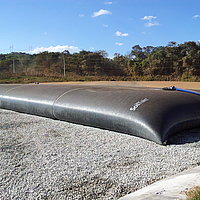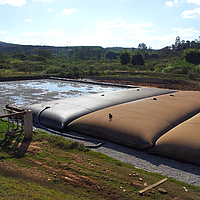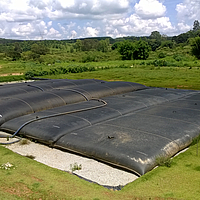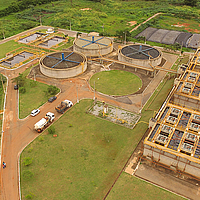Sludge Dewatering at ETE União
Project information
Sludge Dewatering at ETE União
Pará de Minas, Minas Gerais, BR
COPASA
COPASA
COPASA
August 12 - June 13
Project details
The Water and Sewage Company of the State of Minas Gerais - COPASA implemented the effluent treatment system using desiccant geoforms within the effluent treatment unit in Pará de Minas. The objective was to increase the efficiency of the system, which presented a high solids load and a reduction in the productivity of the operation.The SoilTain system installed at the station assists in the removal and conduction of solids deposited and is then followed by polymerization. The system has a 8000 l/h capacity, followed by the insertion of the product in SoilTain DW tubes, where these have the function of filtration, enabling the retention of solids and allowing the filtered water to return to the process, as stipulated by RESOLUTION No. 357 of March 17, 2005 from CONAMA - National Council on the Environment.
Since the sludge consisted of a fine organic material which forms a solution in water which naturally takes a lengthy period to settle out naturally, polymerization was necessary, the process of flocculation increases the size and weight of particles enabling them to dropout of solution quickly and ensuring the correct volume of the fill remains in the tubes. Once the organic sludge is polymerized and inserted in the geosynthetic tubes (arranged in a lined drainage basin), dewatering will occur naturally over time due to gravity until the final solid content defined in the project, in this case 30%, is reached, enabling safe transportation for proper disposal or reuse, according to the disposal plans established in the project
The search for environmentally advantageous and economically feasible solutions for the treatment and final disposal of sludge derived from WWTPs (Sewage Treatment Plants) has been a real challenge for municipalities, since, for the success of effluent treatment, it is necessary to study and detail the most appropriate technique for each case. Dewatering using geosynthetic tubes has been increasingly adopted because it is a sustainable solution with high added value and presents several advantages such as: easy operation, low investment, high efficiency, whilst allowing the material to dewater in a planned and programmed manner, facilitating proper management of the dry solid arisings.




